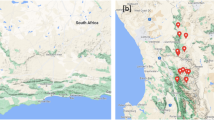Abstract
Differences in the components of the crude drug Saposhnikoviae radix, both wild and cultivated, and the cultivation duration were examined by UHPLC/MS. As a result, there was no significant difference in composition depending on the region in China where the drug was produced. The most abundant components in all samples were prim-O-glucosylcimifugin, 4′-O-glucosyl-5-O-methylvisamminol, 3′-O-acetylhamaudol and cimifugin. The 1 year-old Saposhnikoviae radix cultivated in Japan had a low component content overall. A comparison of components according to root thickness revealed that glycosides, such as prim-O-glucosylcimifugin and 4’-O-glucosyl-5-O-methylvisamminol, were accumulated in thin roots. In a comparison of the components according to the drying temperature, a large difference was observed in the content of glycosides, and a difference was observed depending on the sugar-binding position. According to a metabolome analysis in domestic commercial products by LC/MS, a characteristic component in the cultivated product was found and its content was low in the 1 year-old sample and high in the 2 year-old sample. If the cultivation duration is prolonged up to about 6 years, the contents of the ingredients are close to those of wild products.
Graphical abstract





















Similar content being viewed by others
References
The Ministry of Health, Labour and Welfare of Japan (2016) The Japanese Pharmacopoeia 17th Edition. The Ministry of Health, Labour and Welfare of Japan, Tokyo, pp 1903–1904; The Ministry of Health, Labour and Welfare of Japan (2017) The Japanese Pharmacopoeia 17th Edition Supplement I. The Ministry of Health, Labour and Welfare of Japan, Tokyo, p 137; The Ministry of Health, Labour and Welfare of Japan (2019) The Japanese Pharmacopoeia 17th Edition Supplement II. The Ministry of Health, Labour and Welfare of Japan, Tokyo, p 91
Baba K, Tabata Y, Kozawa M, Kimura Y, Arichi S (1987) Studies on Chinese traditional medicine Fang-feng (I). Structures and physiological activities of polyacetylene compounds from Saposhnikoviae radix. Shoyakugaku Zasshi 41:189–194
Kinoshita G, Nakamura F, Furuhata Y (1987) Inhibitory effects of Saposhnikovia root on CNS functions and peptic ulcers. J Med Pharm Soc Wakan-Yaku 4:130–137
Okuyama E, Hasegawa T, Matsushita T, Fujimoto H, Ishibashi M, Yamazaki M (2001) Analgesic components of Saposhnikovia root (Saposhnikovia divaricata). Chem Pharm Bull 49:154–160. https://doi.org/10.1248/cpb.49.154
Isshiki N(1987) Wakanyaku no ryouhi kanbetsuhou oyobi tyouseihou-Fukkokuban. Taniguchi shoten, Tokyo, pp 48–50
Kouji CY, Kenkyu-in CSK (eds) (1996) Chugoku Yakuzai Sigen Tizu-syu. Yuki-sya, Kyoto
Ding A, Wang Q, Li S, Jiao K (1987) Chemical constituents of Quangangfeng (Saposhnikovia divaricata). Zhongcaoyao 18:247–249
Baba K, Yoneda Y, Kozawa M, Fujita E, Wang N, Yuan C (1989) Studies on Chinese traditional medicine “Fang-Feng”. (II). Comparison of several Fang-Feng by coumarins, chromones and polyacetylenes. Shoyakugaku Zasshi 43:216–221
Shimizu N, Tomoda M, Gonda R, Kanari M, Kubota A, Kubota A (1989) An acidic polysaccharide having activity on the reticuloendothelial system from the roots and rhizomes of Saposhnikovia divaricate. Chem Pharm Bull 37:3054–3057. https://doi.org/10.1248/cpb.37.3054
Shimizu N, Tomoda M, Gonda R, Kanari M, Takanashi N, Takahashi N (1989) The major pectic arabinogalactan having activity on the reticuloendothelial system from the roots and rhizomes of Saposhnikovia divaricate. Chem Pharm Bull 37:1329–1332. https://doi.org/10.1248/cpb.37.1329
Maruyama T, Ezaki M, Shiba M, Yamaji H, Yoshitomi T, Kawano N, Zhu S, Cheng X, Yokokura T, Yamamoto Y, Fuchino H, Sun H, Komatsu K, Kawahara N (2018) Botanical origin and chemical constituents of commercial Saposhnikoviae radix and its related crude drugs available in Shaanxi and the surrounding regions. J Nat Med 72:267–273. https://doi.org/10.1007/s11418-017-1149-7
Zhao B, Yang X, Yang X, Zhang L (2010) Chemical constituents of roots of Saposhnikovia divaricate. Zhongguo Zhongyao Zazhi 35:1569–1572
Sasaki H, Taguchi H, Endo T, Yosioka I (1982) The constituents of Ledebouriella seseloides Wolff. I. Structures of three new chromones. Chem Pharm Bull 30:3555–3562
Kondo Y, Takemoto T (1972) The structure of cimifugin, a new bitter principle from Cimicifuga simplex WORMSK. Chem Pharm Bull 20:1940–1944
Tosun A, Baba M, Bahadir O, Okuyama T (2006) Coumarins isolated from the roots of Seseli vesinosum in Turkey. Pharm Biol 44:528–533
Kim MK, Yang D-H, Jung M, Jung EH, Eom HY, Suh JH, Min JW, Kim U, Min H, Kim J, Han SB (2011) Simultaneous determination of chromones and coumarins in Radix Saposhnikoviae by high performance liquid chromatography with diode array and tandem mass detectors. J Chromatog A 1218:6319–6330. https://doi.org/10.1016/j.chroma.2011.06.103
Nishihara M, Nukui K, Osumi Y, Shiota H (2018) Quality evaluation of Saposhnikoviae radix (Differences between wild-type and cultivated products). Yakugaku Zasshi 138:571–579. https://doi.org/10.1248/yakushi.17-00208
China Medical Science and Technology Press (2020) Chinese Pharmacopoeia (2020 Edition Part 1). China Medical Science and Technology Press, Beijing, p 156
Song Y, Jing W, Yang F, Shi Z, Yao M, Yan R, Wang Y (2014) Simultaneously enantiospecific determination of (+)-trans-khellactone, (+/−)-praeruptorin A, (+/−)-praeruptorin B, (+)-praeruptorin E, and their metabolites, (+/−)-cis-khellactone, in rat plasma using online solid phase extraction-chiral LC-MS/MS. J Pharm Biomed Anal 88:269–277. https://doi.org/10.1016/j.jpba.2013.08.042
Souyaku Shin-iryo gijyutsu kenkyu-kai, Health Policy Bureau, Ministry of Health, Japan (1999) Yakuyousyokubutsu, Saibai to hinshitsuhyouka Part 8. Yakuji Nippo Sya, Tokyo, pp 29–40
http://www.chemspider.com/Chemical-Structure.24699994.html?rid=36220d77-53ca-486a-bc93-250a92328b05&page_num=. Accessed 1 Oct 2020
Xiao Y, Li L, Taniguchi M, Baba K (2001) Glucosides from Pleurospermum rivulorum. Yaoxue Xuebao 36:519–522
Acknowledgements
We thank the Tokyo Crude Drugs Association and The Japan Kampo Medicine Association for kindly providing crude drugs. We thank Mr. Kentaro Kikuchi for providing cultivated materials.
Author information
Authors and Affiliations
Contributions
H.F. and A.H. conceived the project. H.F. managed all experiments and analysis and wrote the manuscript. S.M. conducted most parts of analysis. A.H. cultivated sample materials in the field and provided them. N.K. collected commercial materials and designed experiments. All authors read and approved the final manuscript.
Corresponding authors
Ethics declarations
Conflicts of interest
There are no conflicts of interest to declare.
Additional information
Publisher's Note
Springer Nature remains neutral with regard to jurisdictional claims in published maps and institutional affiliations.
Rights and permissions
About this article
Cite this article
Fuchino, H., Murase, S., Hishida, A. et al. Simultaneous UHPLC/MS quantitative analysis and comparison of Saposhnikoviae radix constituents in cultivated, wild and commercial products. J Nat Med 75, 499–519 (2021). https://doi.org/10.1007/s11418-021-01486-1
Received:
Accepted:
Published:
Issue Date:
DOI: https://doi.org/10.1007/s11418-021-01486-1




